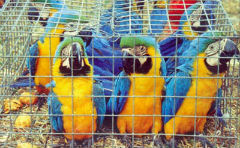Authorities in Colombia say they have dismantled the largest wildlife trafficking ring ever discovered in the country, lifting the veil on the shadowy networks behind a lucrative, but widely underreported transnational criminal activity.
On July 7, Colombian police announced they had taken down a wildlife trafficking ring known as Los Pajareros (The Birders), which they accused of selling and distributing endangered wildlife across Colombia and internationally.
In raids against the network, police arrested eight people and recovered 83 animals, among them parrots, turtles, flamingos, turkeys, toucans, gulls, storks, capybaras, canaries and parakeets.
The arrests are the result of a yearlong investigation that began with a tip off that Heriberto Mateus, alias “El Pajarero,” was selling endangered species in a market in the city of Girardot, El Espectador reported. After putting Mateus under surveillance, police then traced his suppliers, the brothers Jairo and José Luis Algarra Gutiérrez, who allegedly headed the gang.
According to El Espectador, police believe vendors such as Mateus put in their specific requests with Jairo Gutierrez, who paid locals in rural areas between $10 and $17 to source the animals. The animals were then sedated and transported to farms or private houses that acted as distribution centers before being trafficked on to customers or sales points.
The animals were kept at these wildlife warehouses in deplorable conditions, and subjected to cruel treatment such as birds having their feathers dyed to make them more attractive, the police stated.
While many of the animals were then sold in Colombia, police say some were also moved on to Ecuador and Mexico. Police sources told El Espectador they believe the animals were trafficked internationally by sedating them and then concealing them on the person of “mules” or sending them directly to buyers by mail.
Police estimate that 90 percent of the species trafficked by Los Pajareros were endangered and that their operations earned them between $27,000 and $48,000 a month.
InSight Crime Analysis
There are a variety of markets for illegally trafficked Colombian wildlife, both domestic and international. Within the country, there is large demand for turtles and iguanas, which are traditionally consumed over Lent. Internationally, Colombia has become a hub for illegally sourced reptile skins, with Colombian caimans sold on to be turned into clothing and accessories. However, seizures over the years suggest the largest markets, both domestically and internationally, are for birds, reptiles and fish that are sought after as exotic pets.
Globally, wildlife trafficking is worth an estimated $19 billion a year, with 350 million plants and animals sold on the black market annually, according to the Global Initiative Against Transnational Organized Crime. Aside from Colombia, Peru, Mexico, Bolivia and Brazil are also prominent sources of wildlife trafficked around the world, according to the United Nations Office on Drugs and Crime (UNODC) (pdf).
SEE ALSO: Coverage of Eco Trafficking
Despite the huge sums of money on offer and the transnational nature of the crime, comparatively little is known about the criminal structures behind wildlife trafficking. And while Colombian police say that so far this year they have carried out 11,300 operations against wildlife trafficking, recovering 8,300 animals and arresting 1,553 people, these impressive sounding figures mask a broader failure to tackle these networks.
The capture of Los Pajareros, therefore, is not only an unusually big win for the authorities, but it also offers a rare insight into the workings of these trafficking rings.
The details revealed so far show how wildlife traffickers rely on residents in rural areas to source species. Such residents offer local expertise but their services come cheap and they may be unaware of the legal implications of capturing animals or the broader damage they are doing.
The case also highlights the wide reach of traffickers’ sale and distribution networks, which are essential for matching animals with buyers. According to the police, Los Pajareros maintained “innumerous contacts” in the urban centers of Bogotá, Cúcuta, Villavicencio and rural municipalities in the states of Cundinamarca and Tolima, as well as contacts abroad.
In addition, the investigation illustrates the comparatively low tech smuggling techniques used, which rely on mules and standard postal services to transport sedated animals. While these methods have become steadily riskier over the years for drug traffickers, the comparative lack of awareness and resources to tackle wildlife trafficking mean they remain the easiest option for trafficking animals. Police sources talking to El Espectador admitted they were ill-equipped to detect animal trafficking in airports, although said they had begun training sniffer dogs for the purpose.
Finally, the case highlights one of the main obstacles to tackling wildlife trafficking — while the rewards are high the risks are low, even if you get caught. Sentences for wildlife trafficking range from four to nine years in Colombia. Under current sentencing guidelines, people convicted of sentences of five years or less are eligible for alternative penalties such as house arrest, meaning Los Pajareros may not even spend a day in prison, especially if they cut a deal and accept the charges against them.

